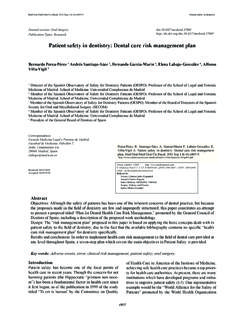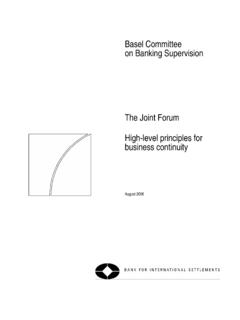Transcription of Chapter
1 Chapter 4. Jobs and social cohesion Jobs can shape social interactions and the ways societies manage collective decision making. They connect people with others and can provide access to voice. J obs influence who we are and our relations with others. In most societies, jobs are a fundamental source of self-respect and social identity. Historically, family names in cohesion can also influence jobs by shaping the context in which entrepreneurs make in- vestment decisions. Empirical evidence of a connection between some cultures were associated with specific oc- jobs and social cohesion is limited by data con- cupations because people defined themselves straints, the complexity of measuring social by what they did: Miller in English, Hurudza interactions, and the multiple factors that can (master farmer) in Shona, and Suthar (carpen- contribute to social cohesion. However, cross- ters) in Hindi. country analysis of values surveys finds that job Jobs connect people with others through loss or lack of access to jobs is associated with networks.
2 The workplace can be a place to en- lower levels of trust and civic engagement. This counter new ideas and information and to inter- is not only a rich-country phenomenon, as is of- act with people of different ethnicities. The dis- ten suggested. Unemployment can cause depres- tribution of jobs within society and perceptions sion, increase mistrust in others, and lead people about who has access to opportunities and why to drop out of community life. Migrants without can shape people's expectations and aspirations social ties may be excluded from job opportuni- for the future, their sense of having a stake in ties that would allow them to succeed in their society, and perceptions of fairness. new environments. In extreme cases, if people, These individual influences of jobs may particularly youth, lack jobs and hope for the fu- have collective consequences. Having or not ture, they may turn to violent or criminal activ- having a job may affect key elements of social ity to compensate for the absence of self-esteem cohesion, the capacity of societies to manage and sense of belonging that a job might other- collective decision making peacefully.
3 While wise provide. Similarly, jobs offering limited op- the frustration of unemployed youth during portunities for future growth or lacking access the Arab Spring suggests that the lack of jobs to voice can lead to alienation and frustration. can be a source of social unrest, that does not Some jobs are positively correlated with so- mean that the relationship between jobs and cial cohesion. Jobs that are empowering, build social cohesion is straightforward, immediate, agency, and provide access to voice can increase or direct. Rather, the relationship is contextual trust and people's willingness to participate in and shaped by individuals, their values, atti- civil society. Jobs can create economic and social tudes, and behaviors, and the institutions that ties and have the potential to build incentives surround them. And it goes both ways: social to work across boundaries and resolve conflict. Jobs and social cohesion 127. And people's trust in government and their con- intergroup relations, and the effectiveness of fidence in institutions may increase if they be- channels for resolving conflicts.
4 Cross-country lieve that job opportunities are available to them data on political stability, the absence of vio- either now or in the future. Jobs can influence lence, and voice and accountability can be used social cohesion through their effects on social to construct an index of social cohesion at the identity, networks, and fairness. country The Nordic countries, Swit- zerland, and New Zealand, score high on this index. Although the index is a static measure, Jobs can help manage social the capacity for peaceful decision making can tensions evolve over time as societies change, through urbanization, more female employment, and News reports about the financial crisis and the the growth of a middle class. Arab Spring have broadcast a common senti- The nature of the interactions through jobs ment that unemployment, especially among affects the degree of social cohesion in commu- young people, can ignite unrest and nities and societies. Trust and civic engagement In September 2010, a Telegraph headline re- are two measurable indicators of social cohe- ported that the IMF Fears Social Explosion' sion at the individual level.
5 These indicators are from World Jobs Crisis ahead of a summit associated with the country-level index of the of the International Monetary Fund and the capacity for peaceful collective decision making International Labour Organization (ILO).2 In (figure ). 2011, Le Monde linked jobs and social unrest Trust refers to the extent to which individu- in Tunisia to concerns about social justice: als have confidence in people whom they know protesters aren't asking the Government to personally, including family and It find them a job, but denouncing the lack of can also refer to trust in people met for the first transparency and justice in the labor market. 3 time and in people of different religions and The revolution in Tunisia was sparked by the nationalities. Civic engagement captures the protests of a fruit vendor frustrated by his in- extent to which people participate voluntarily ability to get a permit to do his job. High lev- in civil society by joining community organiza- els of youth unemployment were a significant tions, unions, political parties, or religious or- contributing factor to the riots in the United ganizations, and by engaging in civic life.
6 These Kingdom in the summer of forms of involvement and activism include These events suggest that jobs can contrib- nonviolent activity, such as participating in pro- ute to social cohesion, including how societies tests, that can be constructive for social cohe- handle differences and manage tensions among sion. Civic engagement relates to social capital, different groups, and how they avoid and resolve participation, and the agency that motivates in- conflicts. There are many possible ways to de- dividuals to be part of collective action. fine social cohesion (box ). But overall, social cohesion refers to the capacity of societies to .. and they are influenced by jobs peacefully manage collective decision Social cohesion thus relates to the processes and Trust and civic engagement can be linked to institutions that shape how groups interact. It jobs. Having or not having a job may af- does not follow that collective decision making fect the way people view the world by influenc- should be imposed from above, but rather that ing their values and attitudes, including trust in channels for voice, accountability, and inclusive others and in institutions.
7 Jobs can also provide participation of diverse groups can contribute channels for people to interact across diverse to a cohesive society. groups. Jobs with certain characteristics may contribute more to trust and civic engagement than others. Trust and civic engagement matter .. Not having a job is associated with less self- The capacity of a country to support peaceful reported trust in high-income countries (figure collective decision making involves multiple ). The relationship is stronger with civic factors including the quality of institutions, engagement, where unemployment is linked to 128 WO R L D D E V E LO P M E N T R E P O RT 2 0 1 3. BOX What is social cohesion? The concept can be traced as far back as the writings of Ibn Khaldun, nomic divisions within society (income, ethnicity, political party, a Muslim scholar born in Tunis in the 15th century, whose idea of caste, language). d asabiyah is generally translated as social cohesion.
8 Living during Although social cohesion has multiple definitions with differ- times of manifold conflicts, Khaldun regarded asabiyah as the soli- ences in focus and emphasis, some common threads emerge: darity of small groups (tribes) that has the power to promote Social cohesion is generally viewed as a positive concept. It can be broader social an end in itself, as well as a means. The Organisation for Economic Four centuries later, Emile Durkheim considered cohesion in Co-operation and Development describes a cohesive society as the context of societal He was particularly con- one that works towards the well-being of all its members. e The cerned with two different types of solidarity that he observed French Commissariat General du Plan defines social cohesion as a emerging through industrialization in Europe. Primitive societies, set of social processes that help instill in individuals the sense of he found, were marked by mechanical solidarity and a strong col- belonging to the same community and the feeling that they are lective ethos based on relatively homogeneous patterns of life recognized as members of the community.
9 F and work. Advanced capitalist society, in contrast, with its complex division of labor, was marked by organic solidarity based on merit, Social cohesion relates to the interactions among individuals, respect for different roles within the labor force, and the need for groups, and societies. These interactions are seen as the forces moral regulation. holding the individuals within the groupings in which they are . More recently, social cohesion has been related to social capital. and as linking diverse groups In the 1990s, Pierre Bourdieu and others focused on the benefits Social cohesion contributes to sustainable social development. that accrue to individuals through their participation in groups and According to the Club de Madrid, shared societies are stable, safe the need for individuals to invest in these relations. Robert Putnam's and just and based on the promotion and protection of all human analysis of the conditions for creating responsive, effective, and rep- rights.
10 , including disadvantaged and vulnerable groups and resentative institutions builds on this theme. Famously, northern persons. h Italy had more of these institutions than southern Italy, and Putnam concluded that the central enabling condition was the existence Last, some definitions of social cohesion relate the concept to pro- of more social capital, measured through the density of local cesses and institutional characteristics. For example, social cohesion Social cohesion can be understood as a broader con- can refer to the capacity of societies (not just groups, networks). cept than social capital in that it considers intergroup relations in to peacefully manage collective action problems. i This definition a wider context. Easterly, Ritzen, and Woolcock define social cohe- links social cohesion to participation and civic engagement. sion (or lack thereof) as the nature and extent of social and eco- Sources: World Development Report 2013 team based on Norton and de Haan 2012 for the World Development Report 2013; OECD 2011.














